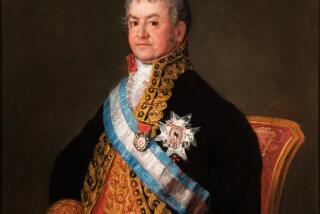COPLEY’S 1771 ‘PORTRAIT’ BOUGHT BY L.A. MUSEUM
- Share via
“Portrait of a Lady,” a 1771 work by John Singleton Copley, one of 18th-Century America’s foremost painters, has been added to the County Museum of Art’s permanent collection.
The museum recently bought the painting at an undisclosed price from an English private collection. Copley’s somber portrait of an unidentified woman goes on public view today in the museum’s gallery of 18th-Century American art and furnishings.
“I’ve always coveted this painting,” said Michael Quick, the museum’s curator of American art. “I’ve had it circled as the most desirable of Copley’s paintings still in private hands.” Though works by Copley still appear on the market, “only a handful of prime pieces” are privately held, according to Quick. They have long since been gobbled up by such Eastern institutions as the Boston Museum of Fine Arts, which owns 67.
“Portrait of a Lady” is only the second Copley painting in the County Museum of Art’s collection, but it is an important addition because it represents his relatively stark period of American realism. The other Copley work owned by the museum is “Portrait of Hugh Montgomerie, 12th Earl of Eglinton” (1780), a flamboyant fantasy done after the artist went to England and indulged in fashionable history painting.
The County Museum of Art acquired “Portrait of a Lady” as a result of what Quick describes as “a peculiar English system called private tender.” Through this process, a prospective seller contacts a dealer who notifies possible buyers and invites bids. Another Copley portrait was offered in this manner to the museum last year. The museum made “a substantial offer” but didn’t get the painting, according to Quick. Copley’s “Portrait of Mrs. Thomas Gage” went to the Timken Art Gallery in San Diego.
When word of the first sale and the museum’s unsuccessful bid reached the owner of “Portrait of a Lady,” he contacted the same London dealer who offered it to the museum in Los Angeles. The painting was purchased with monies from the Ahmanson Foundation, the Board of Trustees’ acquisitions fund and donations by Anna Big Arnold, Jo Ann and Julian Ganz Jr. and Ray Stark.
“The original one got away, but we got a better one,” Quick said, with obvious relish.
The pensive “Portrait of a Lady” depicts a dark-haired woman in a white silken dress relaxing on an elegant, red damask sofa and holding a letter. Her environment betrays a life of luxurious ease but her plain face and equivocal expression reveal an artist more interested in penetrating realism than in flattering his wealthy sitters.
Copley’s unrelenting truthfulness may prevent the portrait from becoming a public favorite, but that probing quality is one reason that Quick so values the painting. “Copley did what (Thomas) Eakins did much later,” he said. “Copley depicted people in all their isolation long before that concept was accepted. People just didn’t do that then. They put forth glamorous images of people who paid for them.”
“During this period, Copley’s work got more somber and simple,” Quick continued. “He used an overstrong, penetrating light to seek out the form and, to some extent, a feeling of weakness in the character. His style grew darker, more severe and searching. In his work of the ‘60s, all the women had pretty faces. In the ‘70s, they were burdened down. He painted her just the way he saw her. There’s a feeling of vulnerability and sadness that no other artist in America had dreamed of doing.
“I’m thrilled that we have this portrait,” Quick said. “With Winslow Homer’s ‘The Cotton Pickers’ and George Bellows’ ‘The Cliff Dwellers,’ it is one of the three best American paintings in the collection.”
Copley grew up in colonial Boston when painters were little appreciated except for their skills in recording the likenesses of leading citizens. Though largely self-taught (after early training from his engraver stepfather), he became Boston’s preeminent social portraitist. Copley had an aversion to travel, but revolutionary unrest and the call of European culture finally convinced him it was time to leave America in 1774. He finally settled in London, where he died in 1815.
The subject of “Portrait of a Lady” was long thought to be Mrs. Thrale, a friend of Samuel Johnson, because the portrait was in the collection of her granddaughter. That theory was proved wrong in the 1960s when scholars noted that the style conformed to Copley’s American work and that the letter in the painting bears a date of 1771. Quick says that the American-period painting probably ended up in England because the sitter was a loyalist who returned there during the Revolution.
An inscription identifying the subject as Mrs. Thrale (applied by an owner of the painting) probably will be removed. After its preliminary showing, the painting also will be cleaned, a process expected to remove a yellow cast, lighten the colors and reveal subtleties of shading.
More to Read
The biggest entertainment stories
Get our big stories about Hollywood, film, television, music, arts, culture and more right in your inbox as soon as they publish.
You may occasionally receive promotional content from the Los Angeles Times.










